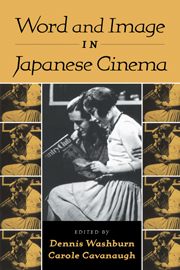Book contents
- Frontmatter
- Contents
- List of Illustrations
- Contributors
- Foreword: Outside Views of the Japanese Film
- Introduction
- PART ONE WORDING THE IMAGE/IMAGING THE WORD
- PART TWO REFLECTIONS OF IDENTITY
- 7 Where's Mama? The Sobbing Yakuza of Hasegawa Shin
- 8 Saving the Children: Films by the Most “Casual” of Directors, Shimizu Hiroshi
- 9 Ishihara Yûjirô: Youth, Celebrity, and the Male Body in late-1950s Japan
- 10 Otoko wa tsurai yo: Nostalgia or Parodic Realism?
- 11 A Working Ideology for Hiroshima: Imamura Shôhei's Black Rain
- PART THREE OUTSIDE THE FRAME OF CULTURE
- Selected Bibliography of Articles and Books in English
- Index
11 - A Working Ideology for Hiroshima: Imamura Shôhei's Black Rain
Published online by Cambridge University Press: 01 March 2010
- Frontmatter
- Contents
- List of Illustrations
- Contributors
- Foreword: Outside Views of the Japanese Film
- Introduction
- PART ONE WORDING THE IMAGE/IMAGING THE WORD
- PART TWO REFLECTIONS OF IDENTITY
- 7 Where's Mama? The Sobbing Yakuza of Hasegawa Shin
- 8 Saving the Children: Films by the Most “Casual” of Directors, Shimizu Hiroshi
- 9 Ishihara Yûjirô: Youth, Celebrity, and the Male Body in late-1950s Japan
- 10 Otoko wa tsurai yo: Nostalgia or Parodic Realism?
- 11 A Working Ideology for Hiroshima: Imamura Shôhei's Black Rain
- PART THREE OUTSIDE THE FRAME OF CULTURE
- Selected Bibliography of Articles and Books in English
- Index
Summary
Japanese cinema returned to the atomic bombing of Hiroshima, after an interval of three decades, with Imamura Shôhei's Black Rain (Kuroi ame). The documentary stylistics of the 1989 film are consonant not only with the vérité approach of many of Imamura's film and television works on other subjects but also with the treatment of nuclear warfare in film internationally. The global nature of atomic weaponry brings Black Rain into a worldwide subgenre of fictional nuclear films that share in the gravity of the historical event they recall, or forewarn, and that, more significant, strive for the look of nonfiction. Examples range from films that quote from evidential or factual footage, such as Resnais's Hiroshima, Mon Amour, or Kubrick's Dr. Strangelove, to those that follow the visual or structural regulations of the documentary, such as the provocative simulations of Peter Watkins's television drama The War Game (1966). The tendency of nuclear films and television dramas to strive for the transparency of nonfiction urges observation of the veristic procedures at work in Black Rain and an inquiry into their ideological implications for Japanese film a half century after the end of the Pacific war.
Perhaps nuclear film simulates or incorporates documentation as a way of returning to its own censored origins, for no images were kept so scrupulously from public view for so long as the films that recorded the actual aftermath of the bombings of Hiroshima and Nagasaki.
- Type
- Chapter
- Information
- Word and Image in Japanese Cinema , pp. 250 - 270Publisher: Cambridge University PressPrint publication year: 2000



